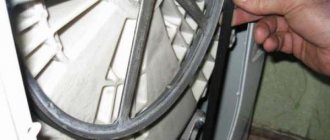A passport washed in a machine is a situation that could be comical if the process of restoring the document took 1-2 days.
However, it may take at least a month to receive it. Therefore, you need to try to revive the document yourself.
Read the article about what to do if you accidentally washed a Russian citizen’s passport in the washing machine, how to dry it and how to use it in the future.
What to do if you washed your passport in a washing machine
Due to such human qualities as forgetfulness or inattention, sometimes unpleasant situations arise, the consequences of which are troubles and difficulties. One of these incidental situations is the accidental damage to a passport or international passport.
There can be many reasons for damage or loss of a passport, from children's games to the theft of a purse with documents, but the most popular is washing the document in a washing machine.
How to deal with such a situation and what to do with a washed document is described in detail in the article.
So, if you have already found yourself in a situation with a washed passport, there is no need to panic and get angry at yourself and those around you. You are not the first person to encounter such a problem, so ways to solve it have already existed for a long time and, with the proper approach, do not cause any particular difficulties.
What's the first thing you should do if you wash your ID? Let's figure it out further.
First steps after washing your passport in the machine
If your passport has been washed in a washing machine, the first thing to do is determine the extent of its damage. The status of the certificate at the end of the process will depend on the set washing mode and the washing powder used. After all, the longer he was in the water, and the stronger the chemical effect, the more likely it was that the seals began to flow and the words lost readability.
If you washed your passport in a washing machine, the procedure should be as follows:
- Carefully remove the ID.
- Examine the extent of damage to the document.
Scroll through the pages of the ID and pay attention to the condition of the stamps and records. If the ink has not flowed and the words remain legible, then there is a real chance to restore the document.
- Separate the pages from each other and place plain white paper or a paper towel between them so that the sheets do not stick together and ink does not bleed onto other pages of the ID.
- Leave your passport until it is completely dry.
The paper towel or paper placed between the pages must be changed from time to time (every 30 - 60 minutes) so that moisture is absorbed as efficiently as possible.
- When the ID is completely dry, close it and place it under the press to straighten the pages.
You can use a thick and heavy book or several books as a press. Leave the structure in this position for a day.
Attention! What you don’t need to do is dry your passport on a radiator. As a result of this drying, the pages will take on a wave-like shape, which is quite difficult to correct.
How will washing affect their condition?
Most often, money that has suffered from mechanical stress when washing clothes does not lose its solvency.
What can happen to paper banknotes?
Washed banknotes naturally lose their original appearance after washing.
However, they retain their payment status. This is due to the use of special paper and special durable paint for their manufacture, which provide the money with sufficiently high strength.
Their usual appearance may change if:
- bleach was used for washing, which will cause the paint on paper bills to fade slightly;
- the washing powder contained chlorine or aggressive components to remove stains;
- clothes could fade, causing paper money to take on an unusual color.
The appearance of paper money remains virtually unchanged if it remains in your pocket during the washing process. This eliminates the possibility of their deformation and transformation into torn fragments. Even in the event of damage and rupture, serial numbers are retained, which allows you to restore the value of banknotes by contacting banking institutions.
What will happen to the coins?
Finding coins in the drum after washing is fraught with consequences not so much for metal money as for the washing machine.
Small items may damage the drum. Therefore, coins must be found and removed to avoid repeated negative impact on the inner lining of the drum.
It is recommended to do the following:
- Rotate the drum by hand, inspect and feel its inner surface.
- Check to see if coins are stuck in the rubber seal, that is, in the hatch cuff.
- Inspect the drain pump filter. It is located at the bottom of the machine body. This is a small panel equipped with a protective cover. You need to open it by scrolling counterclockwise and remove the coins, if there are any.
Metal money may be slightly deformed and nothing more. In addition, they will have an unpleasant odor.
Is a washed passport valid and is it necessary to replace it?
The current legislation does not contain rules defining the degree of deterioration of a passport. According to the content of regulatory legal acts, a damaged or worn-out identity card should be replaced, but nothing is said about its invalidity.
This rule is advisory in nature, since there are no penalties for using a moderately damaged (tattered cover and pages, but readable inscriptions and intact seals) passport. A person has the right to replace a worn-out certificate, but is not obliged to do so, since this document is also valid. In this case, replacing a passport or international passport is a personal matter for each citizen.
If you are not concerned about the aesthetic appearance of the main document proving the identity of a citizen of the Russian Federation, you can use a moderately worn and slightly washed passport.
For this document to be valid after machine washing, it must meet the following requirements:
- all inscriptions must be readable and legible (full name, number and series, date of issue and other data);
- whole seals with ink not leaking.
When presenting an identity card to any government agency or other organizations in this condition, the holder of a damaged passport, as a rule, hears a recommendation to replace it, but no one has the right to refuse to accept the document because of its invalidity.
A washed passport with legible entries and intact stamps can be used, is legally binding and is valid.
If a person accidentally washed his passport on the eve of marriage or another event that requires replacing the ID, he can carry out his plans with the washed document (provided that the above requirements are met), especially since a new passport will be issued subsequently. But if this happened when such an event had already taken place, then it is better to replace the ID in order to avoid thorough checks of the document and constant comments about its appearance. This is especially true for international passports. To avoid troubles during passport control at customs, which may become an obstacle to entry or exit from the country, it is better to take care of replacing a damaged passport in advance.
Is it possible to use a damaged document?
There are no regulatory documents that would accurately determine the level of suitability of an important document. The law states that a damaged document must be replaced, but in this case the personal identification card does not lose its functions and is considered valid. But still, no matter how you look at it, a passport that is too damaged by moisture will have to be exchanged. You can determine how suitable a document is for use solely by the state of its appearance.
There is no need to rush to replace your ID card if the series, number and all important information are still visible. If, when preparing some documents in government agencies, they advise you to change the document, you can safely say that this is included in the immediate plans.
Particular attention should be paid to stamps and signatures; if they have blurred and are no longer clearly visible, then this is a signal to exchange the document.
List of papers required for restoration
If a person washes a passport in a washing machine and it cannot be restored (the ink on the stamps has leaked, the inscriptions are unreadable, the personal data of the passport holder cannot be seen), the document is invalid and will have to be replaced at the passport office. The replacement procedure is not difficult, it just takes some time, so this needs to be done in advance, and not at the moment when deadlines matter.
List of documents required to replace a damaged passport with a new one:
- an old passport, washed in a washing machine and cannot be restored;
- an application on behalf of the owner of a damaged passport to replace the document. The application form must comply with the template established by law (1P);
- 2 photographs in the format established by the Administrative Regulations;
- receipts confirming payment of the state duty. This requirement is provided for in clause 33 of the Administrative Regulations;
- documents required to enter information about the applicant into a new passport (birth certificate, marriage certificate, birth certificates of minor children under the age of 14, extract from the house register to confirm registration). For men, it is mandatory to provide a military ID.
The list of documents is not limited, since if there are additional data about the applicant, which are recorded in the passport, you need to submit materials confirming these data. For example, in the event of divorce, when replacing a passport, you must provide a corresponding certificate.
The replacement of a Russian passport is carried out by employees of the Federal Migration Service at the place of registration of the applicant. The receipt procedure lasts for 10 days from the date of submission of the package of documents. If a person submits documents not at the place of registration, the period for completing the procedure increases to 2 months.
You should not think that all this time your opportunities will be limited due to the lack of an identity document as a citizen of the Russian Federation. After accepting the document, the FMS employee is obliged to issue the applicant a special certificate, which will be a temporary identification document. The certificate form (No. 2P) must comply with the requirements of the Administrative Regulations.
What to do with damaged money
It’s unpleasant, but sometimes this happens - a banknote, or several, or a pack is damaged. In most cases, as they say, it is their own fault - they washed it, poured paint on it, and left it to mold in the basement. What now – count losses? Not always.
Damaged banknotes can be roughly classified into one of three categories:
- which must be accepted in trade enterprises as a means of payment,
- which must be exchanged at credit institutions for new banknotes,
- which cannot be exchanged.
Broken but solvent
The cashier at the store must accept your banknote with minor damage. Torn corners, small stains of paint, punctures, inscriptions, minor abrasions are not a reason for refusal. Even if you glue a banknote torn in two together, you can still pay with it. However, there is a chance that you will not be able to convince the cashier, then the bill will have to be changed at the bank.
They won’t accept it in the store, but they will exchange it at the bank.
If your bill is not accepted at the point of sale or if the damage is objectively great, you can change the money at the bank. However, the bank will also not accept any banknotes; the law sets out clear solvency criteria.
The banknote to be exchanged must retain at least 55% of its area. Moreover, this does not have to be one whole fragment - the available pieces of one banknote can be glued together. The bank will exchange the bill, even if it is assembled from many small fragments.
Who would have thought, but the bank will even accept two halves of different bills. True, there are conditions: there must be only two pieces, and each of them must be no less than 50% of the whole bill. Well, the denomination of the banknotes from which these fragments remain must be the same.
It happens that when checking banknotes in a currency detector, their “incorrect” glow in ultraviolet light is detected. This can happen if you wash money in your clothing pocket. The bank should give you a new one instead of such a banknote.
There is a chance to exchange even heavily damaged money with unreadable details if this happened as a result of a natural disaster, accident or fire. Along with banknotes, you must provide documents about the incident to the bank (accident report, fire certificate). The bank will send all materials for examination and exchange to the Bank of Russia.
Exchange procedure
There shouldn’t be any particular difficulties: come to the bank with damaged money and the cashier will examine it. If he has no doubts about the authenticity and solvency of the banknotes, you will be immediately given new money. There is no need to fill out any documents, and no commission should be charged for this operation.
But if there are doubts, then the banknotes are sent for examination to the Bank of Russia. In this case, you will have to write a statement in free form and make an inventory of the damaged banknotes. The application should indicate how to transfer new money to you if the solvency of the damaged bills is confirmed. The examination can take from several days to a month. Yes, you will have to wait, but this procedure is also free for you.
Unfortunately, if your money is so damaged that it does not meet the solvency criteria, you will simply have to part with it.
Foreign currency
In the event of damage to banknotes of other countries, there is much less reason for optimism. The law does not oblige banks to exchange damaged currency. If a credit institution carries out such operations, it charges a commission for them. Banknotes are sent abroad for examination, and the examination period can take a long time.
Administrative penalty for damage to an identification document of a Russian citizen
If a person washes his passport in a washing machine and after that the document cannot be restored, the consequence is not only the replacement of the document, but also bringing the person to administrative responsibility.
Now, according to the Code of Administrative Offenses of the Russian Federation, such an act entails an administrative penalty in the form of a warning or a fine. The minimum fine is; 100 rubles, maximum -; 300.
The administrative penalty provided for in this article takes place in the event of damage to the passport beyond the possibility of restoration. If the passport is washed in a washing machine, and as a result the inscriptions on the document are not readable and the seals are damaged, it must be changed and a fine must be paid. Otherwise, the passport is valid and it is up to its owner to decide whether to change it or not. Penalties are not provided in this case.
When contacting the FMS with an application to replace your passport, you should remember the following rules:
- A service employee does not have the right to deliberately tear a document. The passport must remain in the condition in which you provided it;
- To pay an administrative fine for damaging your passport, you must be issued a receipt. Payment is not made directly to the person accepting the application;
- The amount of the fine should not exceed the maximum limit established by law (no more than 300 rubles).
If the actions of an official do not comply with the rules, they are illegal and entail appropriate punishment for the violator. To bring such an employee to justice and to protect his civil rights, a person who has become a victim of an illegal act may contact the prosecutor's office. As a rule, such methods of protection against unlawful actions of officials are quite effective.
Administrative responsibility
If I washed my passport in the washing machine, what will happen to me? If the document has lost its appearance, but all the data is readable, then the citizen will only have to pay the state fee. If it cannot be restored and needs to be changed, then the citizen still faces administrative punishment. This may be a warning or a fine of 100 to 300 rubles.
- the employee accepting documents and applications does not have the right to tear a washed passport. The document must remain in the form in which the citizen brought it;
- The fine is paid only upon receipt. Payment cannot be made directly to the person accepting the application without a receipt;
- The maximum fine is 300 rubles. A fee cannot be charged in two, three or five times the amount for an improper type of document.
If an employee of the Federal Migration Service violates the accepted procedure for accepting documents, changes it without permission, increases the amount of the fine, etc., then his actions can be appealed through the prosecutor’s office.
There is nothing wrong with washing or washing your passport. This is a fairly common occurrence. You can change the document at any time without any sanctions or problems for yourself.
How to apply for a replacement document online
If you washed your passport in a washing machine, the document cannot be restored, and there is no time to wait in queues for many hours at the Federal Migration Service; an application for a replacement can be submitted online using the Internet.
The advantages of this method: you can submit an application at any time and anywhere. After accepting the online application, you will be given an appointment during which you will be able to receive the document.
When not suitable
Did the person wash his passport in the washing machine? What to do in such circumstances?
To give the correct answer to a question like this, a citizen must understand when reissue of an identifier is required. This is usually necessary if:
- there are third-party marks in the passport;
- seals, inscriptions and other records have become worn out/smudged/become illegible;
- text is not visible on identifier pages;
- the passport is torn or “colored”.
In all of the above cases, you will have to think about a complete re-production of the document. We'll talk about how to cope with such a task later.
What to do if you washed your passport in the washing machine
Some citizens are careless with their ID cards. If the owner washed the passport in a washing machine, the document will most likely become unusable. But the responsibility to monitor the state of the identity card lies with the citizen himself. What to do in such a situation?
Where to go
Have you washed your passport? What to do? Where to go for help in this case? Let's assume that the document in question was seriously damaged during washing. That is, it needs to be replaced.
A similar service is provided by various government bodies and services. Namely:
- multifunctional centers;
- services such as “My Documents” and “One Window”;
- migration departments;
- Federal Migration Service of the Russian Federation;
- passport offices;
- passport and visa centers.
You can request an ID through GosGosuslugi. Just to use such a web resource, you will first have to register and activate an account.
Is the passport valid?
To understand whether a document needs to be changed, you need to study it carefully. There are no clear rules in the legislation that determine the degree of wear or damage to an identity card. The passport is invalid if:
- pages are missing or damaged;
- any inscriptions cannot be read;
- the image in the photograph has faded;
- stamps or marks have blurred, making it impossible to identify them.
There is no clear criterion in the law to determine whether the entries in the passport can be read or whether they have blurred and become unclear. This issue is resolved by government officials when verifying a person’s identity. To avoid misunderstandings, it is better to replace the document if employees of institutions indicate to the citizen that there are difficulties with the identification card.
If a person washed his passport in a washing machine, then it is worth exchanging the document in any case. If a border guard decides that some signs are unreadable, the citizen will not be able to cross the border. The situation will become more complicated if the owner of the damaged document is not allowed in by foreign employees, and he will have to go back.
Another option is to wait for the document to be changed for other reasons: due to marriage and change of surname, reaching the age of 25 or 45 years, etc. In this case, the individual will pay only 300 rubles.
general information
A passport confirms a person's citizenship. All rights of a citizen can be realized and protected only with an internal passport. An identity card is required to officially get a job, register a marriage, purchase housing, receive medical care, and in many other cases.
Any passport (along with a photograph) must contain the following information:
- Series and number.
- Last name, first name, patronymic of the owner.
- Name of the authority that issued the document.
- Date of issue.
The main document is replaced upon reaching a certain age (20 and 45 years). In addition, the identity card should be changed in the following cases:
- change of personal information (for example, last name upon marriage);
- noticeable change in appearance;
- loss or theft;
- worn-out state of the certificate.
A common reason why a person needs to apply for a new passport is the document getting wet.
Registration of a new document
To find out how to get a new passport, it is worth studying the order of the Ministry of Internal Affairs dated November 13, 2017 No. 851. This document approved the administrative regulations of the procedure. It contains the algorithm of actions of civil servants, a list of required documents, an application form, etc.
You can apply for a replacement passport:
- in the MFC;
- to the “One Window”, “My Documents” or similar service;
- to the police department, where they deal with migration issues;
- by filling out an application on the State Services website.
The algorithm of actions is as follows:
- the citizen collects the necessary documents;
- state duty is paid;
- an application is drawn up;
- documents and application are transferred to an employee of a government agency;
- the application is accepted if all legal requirements are met and the information in the application is correct;
- The registration procedure takes 10 days;
- the citizen comes back to the MFC or the police, receives the previously transferred documents and a new passport.
If you apply electronically, the algorithm is different. The interested party fills out an application through the website, after which the entered information is checked. The person will receive a notification via SMS with an invitation to the Ministry of Internal Affairs. The citizen can submit original documents to the police within 30 days or the application will be cancelled.
Production time and cost
The period for issuing a new certificate in the Russian Federation, regardless of the method of submitting documents, is affected by the place where they were submitted:
- If you applied for a replacement at your place of residence, a new document will be issued in 10-14 days.
- The same deadlines are observed in the case of passport restoration after theft.
- If you are applying outside of your place of residence, a new identity card will be received in two months.
Important! Keep in mind that it will take one to two weeks to collect the necessary documents.
Citizens of Ukraine should contact the State Migration Service with the necessary documents and wait for a month. If there are no glitches in the bureaucratic apparatus, then in thirty days you will become the owner of a brand new passport, but otherwise, the waiting period may double.
Temporary ID
What to do if the passport replacement has not yet occurred, but the document needs to be presented somewhere? To resolve the problem, a temporary identity card is issued.
To obtain it you will need 1 more photograph of 35mm by 45mm. An employee of the Ministry of Internal Affairs will issue a document within 10 minutes immediately after submitting an application for a passport. The certificate is valid for 2 months. Upon separate application, this period can be extended.
Such a document is used for presentation to government agencies, purchasing air tickets, etc. But there are some restrictions, for example, a citizen will not be able to obtain registration or confirm his registration address if necessary.
What documents need to be prepared?
To replace your ID you will need:
- birth certificate (if the original is not preserved, you need to contact the civil registry office to issue a duplicate);
- photo 35x45 mm black and white or color, where the person’s face is frontal (the photo must be taken at the same age as the applicant on the day of application);
- a washed document that needs to be replaced.
Documents are also submitted to confirm other information about the person. If available, the following must be provided:
- birth certificates of children (only needed if children are under 14 years old);
- a document issued at the military registration and enlistment office (registration certificate, military ID or other);
- document confirming marriage;
- divorce certificate.
A receipt confirming the transfer of state duty to the budget is provided at the request of the person. If all the details have been entered correctly, the payment will automatically be displayed in the electronic system, and the Ministry of Internal Affairs officer will see it independently.
Payment for passport replacement
To replace a new ID instead of a washed one, you need to pay 1,500 rubles. You can transfer money:
- via Internet banking;
- online on the State Services website;
- at a branch of any bank;
- using a wallet of an electronic payment system (for example, Yandex.Money);
- through another service that accepts payments.
Application Form
The application for a passport replacement shall indicate:
- code of the department of the Ministry of Internal Affairs where the passport will be replaced;
- details of the washed ID (series, number, date of issue);
- Full name, gender;
- Date and place of birth;
- marital status (if a person is married or divorced, the full name of the wife/husband, the date of marriage, the name of the registry office where the certificate was issued are indicated);
- FULL NAME. parents;
- place of residence (region, town, street, house, apartment);
- place of current stay (indicated if the application for a replacement passport is not submitted to the registration address);
- contact phone number and email (if available);
- the fact of being a citizen of another state;
- requirement to replace passport;
- the basis for replacement is damage;
- date of application and signature of the citizen.
The official records in the appeal:
- list of submitted documents;
- your full name date and signature.
The form further indicates:
- results of inspections, if any;
- information about requests received and the reasons for sending them;
- information about the destruction of the passport (number and date of the act of destruction, name of the migration department that carried out this).
When a person receives a passport after replacement, he signs the same application in the appropriate boxes of paragraph 11.
When can they refuse to replace a passport?
A person will not be issued a new passport in the following cases:
- false information was provided;
- the person is not a citizen of Russia;
- the person has a valid passport;
- information on the transfer of duties is not available in the government payment system.
A written request to replace a document will not be accepted in the following cases:
- the person has not submitted any of the required documents;
- the data entered into the application form is incorrect;
- an individual did not apply for a passport in person;
- photos do not correspond to the approved format;
- the person presented a document (for example, a marriage certificate) not in Russian without a translation certified by a notary;
- It was not possible to personally identify the person who applied for a passport replacement.
Penalty for a washed passport
To find out what fine a citizen will pay, you need to refer to Article 19.16 of the Code of Administrative Offenses of the Russian Federation. Liability under this article arises if the owner of the passport intentionally destroyed it or stored it carelessly, as a result of which the document was damaged.
A person will have to pay from 100 to 300 rubles. The exact amount is determined by an official of the Ministry of Internal Affairs, based on the degree of guilt of the offender. If a citizen voluntarily reported that the passport was washed, does not deny his illegal behavior and repents of it, the penalty will be minimal.
In cases where the card holder insists that he has taken every precaution to preserve the passport, he may be subject to the maximum fine.
The algorithm for bringing to responsibility is as follows:
- An employee of the Ministry of Internal Affairs receiving documents establishes an offense - damage to the passport during washing;
- a protocol is drawn up;
- the protocol is sent for consideration to an official - the head of a department of the Ministry of Internal Affairs;
- the manager studies the materials, interviews the passport holder and makes a decision.
Payment of the fine is made only after a decision has been made in the case. The citizen will be issued a receipt for the transfer of funds according to the details. The fine can be paid within 60 days from the date of the decision.
A passport washed in a washing machine will most likely need to be replaced. To do this, you should contact any migration department of the Ministry of Internal Affairs, pay the state fee, submit an application and attach the necessary documents to it. If the entries in the document are not blurred and are readable, all the stamps and photographs are clearly visible, then the passport can be used.
Lifehacks
Life hacks for every day, as well as a review of proven and necessary products for the whole family.
How to remove coffee from paper
One awkward move and a cup of coffee spills onto important documents. Or you are reading a book and drinking coffee at the same time - as a result, the pages of your favorite book are stained. Coffee stains on paper are noticeable and create a sloppy appearance. What to do in this case? How to remove coffee from paper so that not a trace remains of it. Don't panic, there are special methods that will help you solve this problem.
In this article you will learn simple methods that will tell you how to remove coffee stains from paper.
Main difficulties
Coffee is a tasty and aromatic drink. When coffee hits any surface, it immediately leaves bright traces on it, which are gradually absorbed and become a little lighter. The faster you start removing coffee stains from paper, the better the results will be. You can remove stains if you follow certain rules.
How to remove coffee stains from paper? We offer you simple methods that will help you cope with this problem.
First actions
If you spill coffee on paper, you need to immediately place some cloth or towel on top of the paper (use a cotton cloth if possible). This way, the coffee residue will be absorbed into the fabric, and the stain will not spread across the surface of the paper. Or you can place a paper towel or soft toilet paper on top of the spilled coffee. You will get the same effect.
If coffee grounds get on the paper, carefully brush them off.
Place the soiled sheets on a hard surface so that they do not get wet (there are several sheets, you need to put each one separately).
We use hydrogen peroxide
How to remove coffee stains from paper? For this you can use hydrogen peroxide. The faster you use it, the better the result will be. Take 3% hydrogen peroxide and drop it pointwise onto the coffee stains (if the stains are few and small). If there are large stains and stains on the paper, then you need to take a cotton pad moistened with hydrogen peroxide and gently blot the stains with it. Blot until the dirt disappears. Change the cotton pad every time to avoid smearing coffee on the paper.
We use ammonia
remove coffee from paper using ammonia. If you have ammonia at home, use it, it does an excellent job of removing such stains. The principle is exactly the same as with hydrogen peroxide. Soak a cotton pad in ammonia and apply it to the coffee stains, repeat the procedure after a minute. The only disadvantage of this method is the unpleasant smell of ammonia.
Applying whiteness
How to remove coffee stains from paper if previous methods did not help you? You can use white. You need to be careful with whitening; it may leave white spots on the paper. How to use bleach to remove coffee stains? Wear gloves to protect your hands. Soak a cotton pad in white and apply it to the coffee stain. Periodically replace cotton pads with new ones. This way you can quickly remove the coffee from the paper.
Preparing a special solution
How to remove coffee stains from paperif all the methods listed above did not help you? Try preparing a special solution. Mix water and vinegar in a separate container at a ratio of 5 to 1. Dip the soiled part of the paper into this solution and hold for a couple of minutes. The coffee will gradually begin to disappear from the paper. Then take out the leaf. Place it on a hard surface and start blotting it with paper napkins, changing the napkins until they become dry. Wait until the sheet is completely dry. Then place some weight on it (such as a book) to straighten the sheet.
Another way is to scan the stained document onto your computer. Use Photoshop to cover up the coffee stains and then print the document again.
To avoid this situation, try not to drink coffee near important documents. Or drink coffee from special cups.
Now you know how to remove coffee stains from paper.
Have you encountered a similar problem? How were you able to get coffee out of paper?
What to do if you washed your passport in the washing machine
How many reasons for damage to such an important document as a passport exist in nature? It is difficult to answer this question unambiguously, because there are countless of them, and one of the most common is washing it in a machine. Each of us has encountered this problem at least once in our lives, and the panic that envelops us is familiar to everyone firsthand.
If you find yourself in such a situation, do not worry and try to calm down - you are not the only or first person to come face to face with it. Remember that there is always a way out, and solutions have already been invented by someone a long time ago. With the right actions and courage, you can do without replacing your passport, restoring the document completely.
So that you don’t have to look for bit by bit information on how to dry and preserve a passport, in today’s article we will look at all this in great detail and accompany tips and recommendations with carefully selected photos and videos.
I washed my passport in the washing machine - what to do: step-by-step instructions and recommendations
You will always have time to replace the document, so first you should try to do everything possible to revive it. To avoid making irreparable mistakes, follow the following sequence of actions:
- First, very carefully remove your passport from the pocket in which it was washed and carefully flip through the damp pages to assess the level of damage caused. If the ink does not flow and all the stamps remain in place, you are lucky and can safely proceed to the next steps.
- Carefully separate the wet pages of the ID card and place dry sheets of clean white paper between them without any writing, otherwise this may risk imprinting information on the document. Paper towels will also work.
- Be sure to remove your passport away from any heat sources, be it radiators or convectors. It should dry naturally.
- Change the paper between pages every thirty to forty minutes, this way the moisture will be absorbed faster and the passport will dry more evenly.
- Close the completely dry ID card and place it under an even, heavy press for at least half a day. This will help straighten the pages, and your passport will be as good as new.
Unacceptable actions when drying a washed document
Having figured out how to save your passport after washing, it’s worth focusing on what you absolutely cannot do.
Firstly, never shake the document, try to wring it out, or turn the pages too quickly. This threatens that you will simply tear your ID card and there will be nothing to restore.
And secondly, never try to dry your passport on a radiator or with a hairdryer. This will permanently deform the pages, making them wavy, and a home press will no longer help.
What is the acceptable level of damage?
The current legislation does not provide specific guidance on what damage to an identity card is critical and determines the degree of unsuitability of the document. There are only recommendations for replacing it if it is worn out. Therefore, here you need to rely on external parameters of the document state.
If basic data remains legible in the washed passport, such as: full name, date and place of birth of the owner, series and number of the document, as well as the day, month, year of its issue and all stamps, the identity card is considered valid. Moreover, if you contact any authorities, you may be advised to replace your passport, but in no case have the right to refuse to accept it.
When is it necessary to replace your passport?
There are several criteria under which your identity card will definitely not be accepted at any authority, and you will still have to change it:
- The basic information about the passport holder has blurred, and it is not possible to read it: full name, place and date of birth.
- Signatures, seals and stamps have been damaged, as a result of which it is impossible to establish information about registration, marriage and children.
- One or more pages are missing.
- The photo is seriously damaged, that is, in such a way that it is impossible to determine the person from it.
Required documents to change your identity card
If a situation does arise that your passport could not be saved and you have to change it, here is a list of the main papers you will need:
- 2 photo cards 3.5×4.5 cm;
- an old copy of the document that has fallen into disrepair;
- receipt of payment of state duty;
- application for replacement of a standard passport;
- additional documents: birth certificate, extract from the house register, military ID (if available), marriage/divorce certificate, birth certificates of children under 14 years of age.
The main thing is to remember that it takes 10 working days to replace an identity card at your place of registration, and up to 2 months if the request is not at your place of residence, so take care of this in advance.
Be careful and keep a close eye on things so as not to fall into such funny situations. And we, in turn, hope that our advice turned out to be really useful and helped you save time and nerves, and most importantly, saved an almost lost document!
Is it necessary to change a damaged document?
Is it worth changing a slightly damaged passport right away or is it better to wait? This issue needs to be decided by the owner. In the event that the identity card will soon have to be replaced as planned, you can use a washed passport for some time. However, if due to a change of name a replacement is not planned, then it is better to immediately contact the passport office.
To get a new passport, you will need to bring a damaged copy, write an application and go to the bank to pay the state fee. We must not forget that you will need several photographs. To exchange a document that was damaged due to the fault of the owner, you must pay a fine, which, however, is completely symbolic.
If your passport is accidentally washed, it should be replaced immediately. Such an identity card is considered unusable, even if all inscriptions and stamps are preserved. Thanks to timely exchange, you can save your nerves when going through passport control.
If your passport is damaged abroad, you need to contact the nearest police station, they will issue a special certificate.
There is no need to be too nervous if your ID suddenly turns out to be washed. If you were unable to return your passport to its original appearance on your own, then you need to take a photo and go to the passport office at your place of registration.











